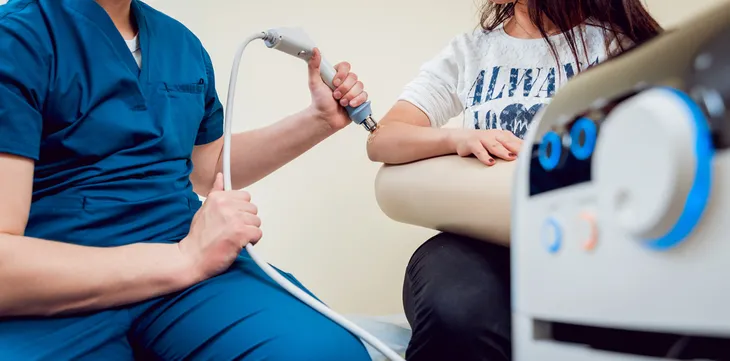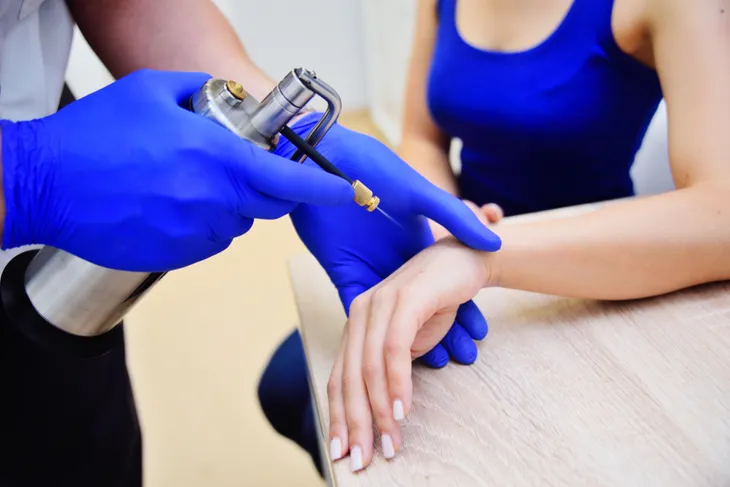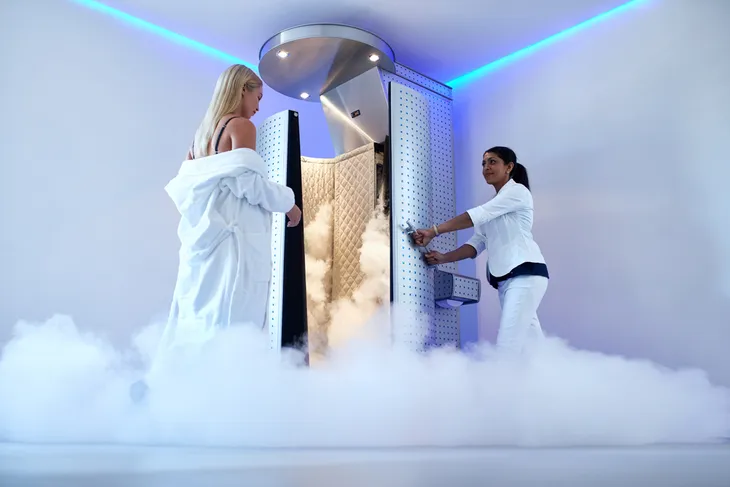- Cryotherapy is a technique that exposes a part of the body or the whole body to extremely cold temperatures for therapeutic purposes.
- Localized cryotherapy is used by health professionals whereas whole-body cryotherapy is not — it’s more like a spa treatment that is offered at spas and wellness centers.
- Cryotherapy offers some benefits but it also has risks, which is why it’s important to get informed.
Cryotherapy, also known as cold therapy, is the use of extremely cold temperatures to help treat a variety of issues. Its most prominent use is for surgical treatment, known as cryosurgery or cryoablation, however, it’s gaining popularity as a full-body treatment. This is known as whole-body cryotherapy.
While there is plenty of anecdotal evidence that suggests cryotherapy has tons of health benefits to offer, it is still a fairly new form of treatment and as such, it’s still being researched. Because of this, it’s very important to discuss cryotherapy with your doctor to find out if it’s right for you. In the meantime, here’s what you need to know about cryotherapy including, what it is, the potential benefits, and its risks.
What Is Cryotherapy?
Cryotherapy is a technique that exposes a part of the body or the whole body to extremely cold temperatures. Treatments typically only last a few minutes.
Cryotherapy can be used to treat one area on your body either externally (on your skin) or internally (inside the body). When treatment is used internally, this is called cryoablation which aims to destroy abnormal cells. You can also receive cold therapy for your whole body, known as whole-body cryotherapy, which we’ll explain in more detail later in this article.
Medical Uses for Cryotherapy
Cryotherapy can be used to treat a variety of ailments and it’s minimally invasive. The goal of cryotherapy is to remove damaged or diseased tissue, explains the Cleveland Clinic.
The source says the following are common medical conditions that may use cryotherapy as a form of treatment:
- Skin conditions, such as warts, skin tags, or dark spots
- Bone cancer, cervical cancer, liver cancer, or prostate cancer
- Precancerous skin conditions and early-stage skin cancers, such as squamous cell carcinoma and basal cell carcinoma
- Retinoblastoma (cancer of the retina in children)
How Does Cryotherapy Work?
Receiving any new medical procedure can be daunting because you don’t know what to expect. But rest assured, cryotherapy is a minimally invasive procedure. During cryotherapy, your doctor will apply extreme cold to abnormal tissue with the goal of destroying the cells.
There are a variety of substances that can create cold temperatures, including liquid nitrogen, liquid nitrous oxide, and argon gas. Never perform cryotherapy on yourself. It must be administered by a health professional.
What to Expect During Cryotherapy
If your doctor recommends external cryotherapy, you can expect to receive the treatment from a spraying device or cotton swab. The Cleveland Clinic says liquid nitrogen is usually used for external cryotherapy.
Internal cryotherapy, on the other hand, is administered by inserting a cryoprobe through a small incision in your skin. Your doctor may use ultrasound imaging to help guide the cryoprobe to the area. Local anesthesia or general anesthesia may also be necessary depending on the location.
What to Expect After Cryotherapy
Since cryotherapy is typically minimally invasive, you can expect to have mild pain afterward. After external cryotherapy, you can expect the treatment area to turn red and it may also blister, according to the Cleveland Clinic. The area will then form a scab that heals within 1- to 3-weeks. If you do experience mild pain, it typically goes away after 3-days.
Internal cryotherapy may cause mild pain or soreness in the affected area. You can also expect this to last for up to 3-days. The source also notes that women who receive internal cryotherapy on the cervix may have “watery discharge for a few days to a few weeks.”
The Benefits and Risks of Medical Cryotherapy
The biggest benefit of cryotherapy is that it is minimally invasive, especially compared to traditional surgery. Cryotherapy typically causes less pain and the Cleveland Clinic says it has “a lower risk of damaging healthy tissue near the abnormal cells.”
As with all treatments, there are potential risks, though the risks are small. Some potential complications are swelling, scaring, or a skin infection. Nerve damage, bone fractures, and cramping or pain are also possible. If you’re receiving medical cryotherapy, be sure to discuss the potential risks with your doctor.
 novak.elcic / Shutterstock
novak.elcic / ShutterstockWhat Is Whole-Body Cryotherapy?
Whole-body cryotherapy has been gaining popularity lately but it’s important to note it’s not a medical treatment and doesn’t require a prescription from a doctor. According to WebMD, whole-body cryotherapy is often offered at spas, wellness centers, and sometimes gyms.
Whole-body cryotherapy involves special tanks or chambers that are cooled to extremely low temperatures, ranging from -200 to -300 degrees Fahrenheit. During treatment, you’ll stand in the enclosed tank with your head exposed at the top. Treatment lasts between 2- to 4-minutes.
While whole-body therapy isn’t an FDA-approved treatment for any condition, there is anecdotal evidence that suggests it may have some benefits. Let’s take a look at what some of those benefits are next.
Whole-Body Cryotherapy Benefits: Arthritic Pain Relief
Arthritis sufferers know how debilitating the pain can be. Luckily whole-body cryotherapy may be able to provide some relief. According to Healthline, one study found that whole-body cryotherapy significantly reduced pain in individuals with arthritis.
Not only was the treatment “well-tolerated,” but it also “allowed for more aggressive physiotherapy and occupational therapy as a result,” explains the source. This suggests that whole-body cryotherapy may make rehabilitation programs more effective.
Whole-Body Cryotherapy Benefits: Treat Skin Conditions
Whole-body cryotherapy may also help treat some chronic skin conditions, such as atopic dermatitis. Healthline says this is because the treatment can help reduce inflammation as well as improve antioxidant levels in the blood.
The source notes that both targeted cryotherapy and whole-body therapy can help treat atopic dermatitis. It may also help treat acne when targeting the sebaceous glands.
Whole-Body Cryotherapy Benefits: Preventing Cancer
We already know that medical cryotherapy can be an effective treatment option for certain forms of cancers but how does it work exactly? During targeted cryotherapy, the treatment is applied to abnormal skin tissue and can effectively destroy cancer cells. It also turns out that whole-body therapy may help too.
Medical News Today says whole-body cryotherapy may lower your risk of developing cancer cells in the first place. This is largely due to the fact that it may reduce inflammation in the body. That said, more research is still needed.
Whole-Body Cryotherapy Benefits: May Treat Mood Disorders
Healthline says there is also some evidence that suggests whole-body cryotherapy can help treat mood disorders. The source explains that the extreme cold temperatures from therapy “can cause physiological hormonal responses.”
The release of some hormones may positively impact those suffering from mood disorders like depression or anxiety. It’s worth noting, that this shouldn’t be used as a replacement for treatment prescribed by your doctor but it may be effective when combined with your medical treatment plan. Talk to your doctor to assess if whole-body cryotherapy is right for you.
The Risk and Side Effects of Whole-Body Cryotherapy
Though there is some anecdotal evidence that suggests whole-body cryotherapy is effective, we want to emphasize that it is not an FDA-approved form of treatment. You should always consult your doctor before trying it to ensure it’s safe for you.
Additionally, Healthline notes there are some common side effects to be aware of. For starters, it may cause numbness, tingling, redness, or irritation of the skin. While side effects are often temporary, you should see your doctor if they don’t resolve within 24-hours.
It’s also vital that you don’t use it for longer than the recommended time, which is 4-minutes maximum for whole-body cryotherapy. Cryotherapy is also not suitable for individuals with diabetes or conditions that affect their nerves. These conditions can make you unable to feel its effects which may lead to more nerve damage.














